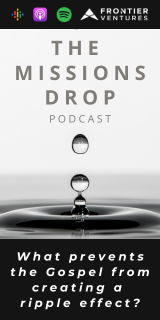Are You Ready for Purpose-Driven Mission?

Even if you wanted to, it would be hard to ignore Rick Warren and the Purpose-Driven movement he has nurtured. Building on the earlier success of The Purpose-Driven Church, Warren’s Purpose-Driven Life has sold more than 20 million copies in the U.S. alone – in a little more than two years – and is now the best-selling hardback book (other than the Bible) in American history. TIME magazine has named Warren not only one of America’s 25 most influential evangelicals but also one of the 15 “people who mattered most” in 2004.
Founded by Warren in 1980, Saddleback Church of Lake Forest, California has grown to 20,000 members and has become the “mother ship” for the Purpose-Driven Movement begun in 1985. Each Monday Warren e-mails his “Toolbox” newsletter to 136,000 subscribing ministers.
But Purpose-Driven is more than an American phenomenon. The Purpose-Driven Life has been translated into 28 other languages and is licensed in 56. Warren says that he has trained 400,000 pastors worldwide and that the Purpose-Driven church model has been employed in at least 122 countries.
And now this worldwide movement is preparing to kick into a new gear with the P.E.A.C.E. Plan, an acrostic-laden program for Purpose-Driven Mission. After two years of preparation and pilot experiments in 47 countries, P.E.A.C.E. is scheduled for an official launch at Saddleback Church in October 2005, with others in the movement expected to follow.
Building on the sequence in Acts 1:8, Warren explains that Purpose-Driven is seeking to progressively move the Church from self-centeredness to unselfishness. If The Purpose-Driven Life retools your life in “Jerusalem”, and The Purpose-Driven Church immerses you in community within your “Judea and Samaria,” then P.E.A.C.E. aims to launch church-based, short-term small groups to the “uttermost parts” as catalysts for long-term, cross-cultural mission. Ready or not, Purpose-Driven Mission is coming soon to a neighborhood near you.
But what is it? A sneak preview can be found on the Saddleback Website (saddlebackfamily.com/peace). Mission Frontiers has obtained further details from a variety of pre-launch documents, correspondence with program planners, and participation in a February 2005 briefing given to selected Purpose-Driven pastors invited to Irvine, California.
The picture that emerges is that of a plan quickly looping through successive iterations. “We’re making this up as we go along,” observes Warren, yet Southern California casualness is here accompanied by careful engineering and shrewd marketing. Warren holds graduate degrees in missions from two seminaries, and he has assembled a team of 25 working full-time on P.E.A.C.E., including experienced leaders from Campus Crusade for Christ, the JESUS Film Project, and the International Mission Board of the Southern Baptist Convention. This team, coordinated by Mike Constantz, is actively soliciting feedback and tinkering further before the October launch.
What Is Clear
Those who care about frontier mission can find much to celebrate in the P.E.A.C.E. Plan. First, Warren and his team give prominence to unreached peoples. Warren proclaims himself a long-time fan of Ralph Winter and the U.S. Center for World Mission, and his team is leaning heavily on the International Mission Board’s tally of “unengaged” peoples awaiting pioneer efforts.
Second, Warren is eager to “turn an audience into an army,” to actively mobilize the “worldwide distribution network of millions of local churches” for mission. He describes Saddleback and Purpose-Driven as small group factories building distribution centers for the “next Reformation” characterized by energized behavior as well as belief. “Judge a church not by its seating capacity but by its sending capacity” is a sermon likely to evoke Amens from many corners.
Constantz elaborates that P.E.A.C.E. involves more than short-term mission efforts from one country to another and that local church members in their own country are key to the plan. He adds, “Local church members (‘every member on mission’) need to be mobilized to help fulfill the Great Commission and the Great Commandment right where they live as well as reaching out to the unreached peoples with unchurched areas within their own countries.”
Third, P.E.A.C.E. is holistic, attempting to attack the “five global giants” of spiritual emptiness, lack of servant leaders, poverty, disease, and ignorance. The fivefold remedy weaves frontier mission into a larger tapestry: Planting churches, Equipping servant leaders, Assisting the poor, Caring for the sick, and Educating the next generation. (See figure 1.) Warren likens P.E.A.C.E. to a common computer “operating system” that provides a base for a wide variety of “application programs”, such as denominational variations. Assisted by mission agencies, P.E.A.C.E. planners are developing various forms of “just-in-time training”, including “kits” or “boxes” anticipated for P.E.A.C.E. small groups to use once they’re on-site among the giants: Clinic in a Box, Church in a Box, Leadership Training in a Box, Business in a Box.
Fourth, the P.E.A.C.E. team acknowledges that they’re on a learning curve and welcome counsel from a wide variety of sources. Warren acknowledges that “there’s a downside to every strategy” and proclaims that “we don’t have ego in this process.” (See sidebar, “We’re Open to Feedback.”)
What Is Not So Clear
The Saddleback Website heralds P.E.A.C.E. as a plan “that re-establishes the church as the primary means God uses to fulfill the Great Commission to all people groups in every country of the world.” At the February 2005 briefing Warren heralded the 21st century as the century of the local church and proclaimed, “It’s time for the church to be the church.”
However, as documented by Ralph Winter and others, both local congregations and apostolic mission structures are biblical, legitimate, and necessary expressions of the “Church.” Winter’s “Two Structures of God’s Redemptive Mission” (posted to the MF Website with this issue) describes how in the past 2000 years apostolic mission structures (beyond the local church) have formed the cutting edge of cross-cultural outreach. That’s not likely to change in the 21st century.
On the one hand, Warren declares, “I believe in full-time missionaries,” and P.E.A.C.E. literature calls for agencies with expertise and resources to become P.E.A.C.E. Partners. (See figure 2.) Yet when asked about concerns mission agencies might have about P.E.A.C.E., Warren says, “They’re just not enough; we need both, but we can’t put new wine in old wineskins.” Observers may well ask if the “new wine” of Purpose-Driven small groups must indeed remain separate from wineskins created by others. (See sidebar, “Is There a Better Way?”)
Stay Tuned!
Despite these cautions, observers of the P.E.A.C.E. Plan can be encouraged that it is still a work in progress and that its designers are seeking to listen to others. At this stage elasticity may be queen of the virtues. Leaders at the U.S. Center for World Mission, among others, have met with Warren and other P.E.A.C.E. leaders and have been invited to participate in ongoing dialogue. Stay tuned for further reports as P.E.A.C.E. evolves further. Churches and mission agencies alike will want to follow this story closely.
Meanwhile, Mission Frontiers readers can make their voices heard via letters to the editor ([email protected]) and by directing feedback to P.E.A.C.E. planners at [email protected].








comments